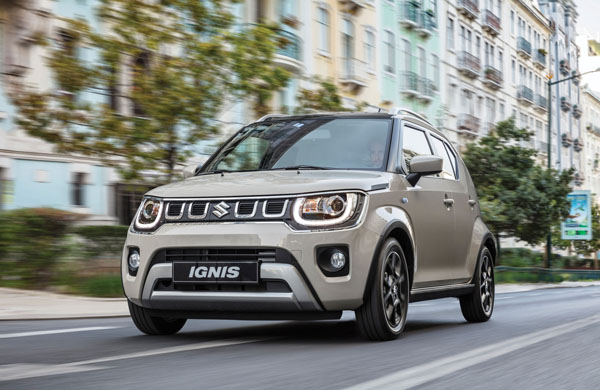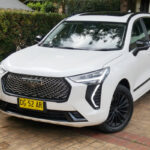
The revamped compact Suzuki SUV / hatchback has an engaging ‘funk factor’, according to Stephen Craig, general manager, sales and marketing for Suzuki Queensland, the source of our test vehicle.
“Aesthetically, it blends with the revitalised cityscapes where former warehouses and mercantile shipping buildings now are homes to trendy design-savvy professionals,” he says.
“It also blends perfectly with the CBD and city fringe urban landscape from a practical point of view, where it easily slots into compromised parking spaces.”
So, there you are… Anyhow, make up your own mind when considering it, or others in this class.
Coming in two variants – GL and GLX – the entry-level GL enters the market at a drive-away price of $18,990 for the five-speed manual, with CVT continuously variable transmission adding $1000.
The GLX, which adds climate control air con, upgraded sound system, different interior trim and 16-inch alloy wheels, among other features, tops out at $20,990.
Genuine Suzuki accessories can customise the Ignis with a range of colours for the surrounds on the centre console, transmission, surrounds, grab handles on the doors, rear view mirrors and fog lights.

Also included are colour coordinated grille trim and centre garnish, wheel decals, side stripes and C-pillar gill slits. In keeping with the season, the test car sported red highlights on a white background. Ho-ho-ho!
STYLING
The new exterior, according to Suzuki, takes its cues from contemporary urban design trends as illustrated by inner-city revival architecture. This is particularly emphasised up front with the new radiator grille. Below this sits a bolder lower grille and air dam.
INTERIOR
Remembering the Ignis is less than 3.7 metres long and 1.7 metres wide, the hatchback’s upright stance gives rise to generous head room in the cabin, which also is matched by good shoulder space and a fair amount of knee room in the rear.
Interior accents depend on the exterior colour, with white, grey and black getting dark blue tones on the centre console, door grips and seat stitching; red, ivory and hues silver.
Standard appointments include cruise control with speed limiter, tinted windows, leather covered three-spoke sports-style steering wheel with audio and cruise controls and hands-free phone operation.
INFOTAINMENT
A 7-inch touch screen provides access to a radio channels, music, auxiliary inputs, USB and SD card access, while smartphone comes via Apple CarPlay, Android Auto and Mirror Link, as well as the screen delivering satellite navigation and rear-view camera vision for help when reverse parking.

ENGINES / TRANSMISSIONS
The Ignis GLX is powered by a 1.2-litre four-cylinder petrol engine with light-on outputs of 66 kW of power at 6000 rpm and 120 Nm of torque at 4400 rpm, mated with a continuous variable automatic transmission.
Claimed fuel consumption of 4.7 litres per 100 kilometres is the reward for such placid performance.
SAFETY
Sadly, the Ignis has a dearth of the latest active safety technology such as autonomous emergency braking, lane-keeping assistance, blind-spot monitoring or rear cross-traffic alert and no roadside assist.
However, all models do get dual front airbags, side airbags and curtain airbags, six in all.
DRIVING
It was a dark and stormy night but the little Ignis GLX, with grown-ups in all seating positions on board, made the short trip from restaurant to occupants’ homes with nary a protest, apart from the odd unexpected sharp shift down of the CVT under the excess load.
With 180 mm ground clearance, the Ignis handled minor inundation of suburban streets with space to spare.
Indeed, the only complaint from the back was the opening of the power windows, letting in rain, by occupants inadvertently leaning on the door armrest-mounted switches.
As mentioned above, a top performer in fuel economy, the manual GL comes with a miserly consumption of just 4.7 litres per 100km on the combined urban / highway cycle. The CVT car claims 4.9 litres.
Actual fuel consumption of our GLX test car ranged from 6.1 litres per 100 kilometres in the suburban environment and as low as 3.9 litres per 100 kilometres on a motorway run.
A trip computer is easily accessible from controls on the steering wheel and displays information including instant and average fuel consumption, driving range to empty and average speed.
Suzuki, for some reason, takes a detour on conventional thinking by offering a 50:50 split rear seat on the GLX rather than the 60:40 on the GL. In effect, that means Suzuki has four and five (say four-and-a-half seat) versions. Like the seating, I’m ambivalent here.
SUMMARY
Looking beyond the lack of safety technology, the Ignis GLX is a proficient compact passenger car with interior space and splashes of design highlights that set it apart from most rivals in the segment.
AT A GLANCE
Suzuki Ignis GL Manual $18,990 driveaway
Suzuki Ignis GL CVT $19,990
Suzuki GLX CVT $20,990
SPECIFICATIONS (Suzuki Ignis GLX 1.2L Dualjet 4-cylinder petrol, CVT automatic, FWD SUV)
ENGINE:
Capacity: 1.242 litres
Configuration: Four cylinders in line
Maximum Power: 66 kW @ 6000 rpm
Maximum Torque: 120 Nm @ 4400 rpm
Fuel Type: Premium unleaded petrol 98 RON
Combined Fuel Cycle (ADR 81/02): 4.7 L/100km
DRIVELINE: Continuously variable automatic transmission, FWD
DIMENSIONS, WEIGHT AND CAPACITIES:
Length: 3700 mm
Wheelbase: 2435 mm
Width: 1690 mm
Height: 1595 mm
Turning Circle: 9.4 metres
Kerb Mass: 905 kg
Fuel Tank Capacity: 32 litres
BRAKES:
Front: Ventilated disc
Rear: Drum
STANDARD WARRANTY:
Five years / unlimited kilometres











